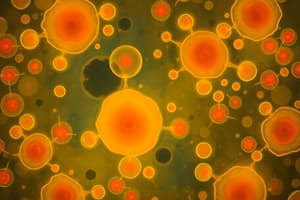Podcast
Questions and Answers
What is the largest organelle in the cell?
What is the largest organelle in the cell?
nucleus
What type of genetic material does the nucleus contain?
What type of genetic material does the nucleus contain?
deoxyribonucleic acid (DNA)
What structures are widely distributed throughout the cytoplasm?
What structures are widely distributed throughout the cytoplasm?
- Lysosomes
- Golgi apparatus
- Mitochondria (correct)
- Endoplasmic reticulum (correct)
The Golgi apparatus is typically located far from the nucleus.
The Golgi apparatus is typically located far from the nucleus.
What is the gel-like medium in which cytoplasmic organelles are suspended?
What is the gel-like medium in which cytoplasmic organelles are suspended?
What provides structural support for the cell and its organelles?
What provides structural support for the cell and its organelles?
What is the semifluid interior portion of the nucleus called?
What is the semifluid interior portion of the nucleus called?
What is chromatin composed of?
What is chromatin composed of?
Which type of chromatin is condensed?
Which type of chromatin is condensed?
How do mitochondria typically move around the cell?
How do mitochondria typically move around the cell?
Flashcards are hidden until you start studying
Study Notes
The Cytoplasm
- Contains a variety of organelles, many of which are surrounded by membranes.
- The largest organelle is the Nucleus, which is surrounded by a membrane called the nuclear envelope.
- The nucleus contains the cell's genetic material, DNA (Deoxyribonucleic Acid)
- The Endoplasmic Reticulum is an extensive system of flattened, membrane-bound tubules, sacs, and cisterns. It is found throughout the cytoplasm.
- The Golgi apparatus is a separate system of membrane-bound sacs, usually found near the nucleus.
- Mitochondria are large, elongated organelles found scattered in the cytoplasm. They are surrounded by a smooth outer membrane and a convoluted inner membrane.
- Other membrane-bound structures in the cytoplasm include:
- Intracellular transport vesicles
- Lysosomes
- The organelles are suspended in a gel-like medium, called the cytosol, where many metabolic reactions occur.
- The cytosol contains a network of tubules and filaments, which make up the cytoskeleton.
- The cytoskeleton gives structural support to the cell and its organelles.
- It also provides a mechanism for transporting materials within the cell and for cell movement.
Membranes
- Membrane boundaries separate biochemical and physiological processes within the cell.
- Enzyme systems are anchored to membranes, making them the site of many biochemical reactions.
- All eukaryotic cells begin life with a nucleus.
The Nucleus
- A double-membraned sac that holds an eukaryotic cell’s DNA.
- Nuclear envelope: A pore-riddled double membrane that controls which substances enter and leave the nucleus.
- Nucleoplasm: The semifluid interior portion of the nucleus.
- Nucleolus: A rounded mass of proteins and copies of genes for ribosomal RNA used to construct ribosomal subunits. These subunits pass through nuclear pores into the cytoplasm, where they join and become active in protein synthesis.
- Chromatin: The total collection of all DNA molecules and associated proteins in the nucleus; all of the cell's chromosomes.
- Chromosome: One DNA molecule and many proteins associated with it.
Chromosomes
- Chromatin represents all the DNA molecules, along with their associated proteins, within the nucleus.
- The genetic material is distributed amongst a specific number of DNA molecules.
- The number of DNA molecules is characteristic for a particular type of organism and cell, but varies widely between species.
Types of Chromatin
- Heterochromatin: Appears as aggregates of coarse granules in electron microscopy (EM) and as basophilic clumps in light microscopy (LM). It is condensed chromatin.
- Euchromatin: Appears as finely dispersed granular materials in EM and as lightly stained basophilic areas in LM. It is extended, uncoiled chromatin.
Mitochondria
- Vary in size and shape, often elongated and sausage-shaped.
- Mobile and move around the cell using microtubules.
- Tend to...
Studying That Suits You
Use AI to generate personalized quizzes and flashcards to suit your learning preferences.




